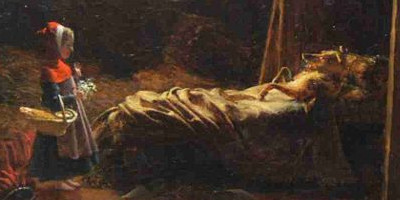
Most modern versions of fairy tales come from two sources: The Grimm Brothers from Germany, and Frenchman Charles Perrault, the collector of the “Mother Goose” tales. The big change they made to this one was the ending. That woodsman showing up seemed a little like a third act re-write of a movie due to bad test screenings, didn’t it? Where the hell did the woodsman come from?
Well, the woodsman was a later addition to the tale. In the early versions of the story, Red and her Grandmother are dead. The. Goddamn. End. Also, in most versions the woodsman cuts the pair out of the wolf’s belly, where they’re mostly none the worse for wear despite being eaten, which implies to us the wolf in that story world eats like some sort of python, by unhinging its jaw and swallowing prey whole. Suspension of disbelief only goes so far.
Much earlier versions also liked to spice up the sexuality angle of the story, by having Red outwit the wolf by performing a striptease for him while he’s lying in bed dressed as her Grandmother, and then running away while he’s “distracted” (Note to any young girls out there: if you are ever abducted and menaced by someone, DO NOT DO THIS).
Wait, it gets worse. This is the most horrifying bit that got filtered out before the tale reached both the Grimm’s and Perrault (and in fact, only made it into a few written texts). In this version, the Wolf dissects Grandmother, then invites Red in for a meal of her flesh, presumably with a side of fava beans and a nice Chianti. Then he eats her, too.
2. Snow White
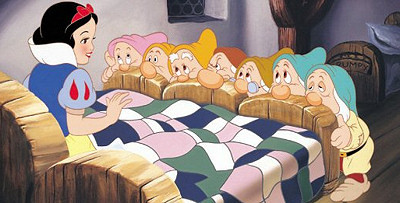
In the Disney film the wicked step-mother winds up dead (she falls off a cliff). So that’s pretty hardcore we guess. It’s got nothing on the Grimm version, though, where the step-mother is tortured by being forced to wear red-hot iron shoes, and made to dance until she falls down dead (you can picture the puppet thing from Saw spelling this out for her over a closed-circuit monitor).
The issue of Snow’s actual age is a point of contention as well. The Grimm’s explicitly refer to her as being seven years old when the story starts, and while there’s no firm indication of how much time has passed, it’s no more than a couple of years. So unless that’s an eight-year-old Prince Charming who comes along and rescues Snow, we’re backing away from this one before we become the subject of an NBC reality show.
The biggest change, and the bloodiest, is step-mom’s … unusual eating habits. Namely, when she asks her man to bring back the heart of Snow White, she isn’t just after proof the girl is dead. She wants to eat it. Depending on the version of the story, the Queen asks for Snow’s liver, lungs, intestines and pretty much every other major internal organ, up to and including one gruesome version where she asks for a bottle of Snow’s blood stoppered with her toe.
3. Rumplestiltskin
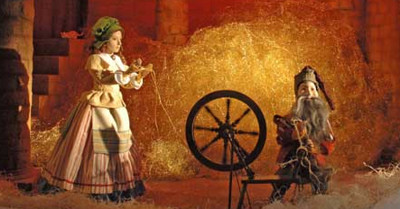
In the Grimm brothers’ version, taken from the oral tradition, the little man is so pissed off he stamps the floor in his little hissy fit, and gets stuck. And then, like some insane version of a Will Ferrell skit, he pulls so hard to free himself that he tears himself in half. Now, if our names were Rumpelstiltskin and some dizzy miller’s daughter had just told the whole damn room, we’d be pissed too, but we don’t think we’d get dismemberment-angry.
Not to mention, in the really early versions of the tale, Rumpelstiltskin launches himself at the girl in a rage and gets stuck … um … in her lady parts. Seriously. The palace guards all have to come and pull him out, which must have made for some awkward looks afterwards.
Also, in a depressingly large number of versions, the child is killed anyway, either by Rumpelstiltskin himself, or the guards, or someone. They weren’t big on happy endings in the Dark Ages. Plague will do that.
4. Sleeping Beauty
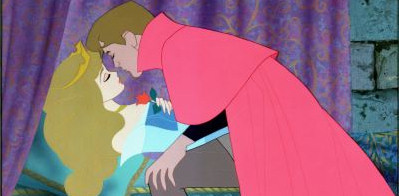
The first major departure in this from the version we know today is when the Princess pricks her finger on her 15 birthday. In earlier versions the Princess instead gets a piece of flax caught under her fingernail which pricks her and puts her to sleep. This might seem like a small difference but it becomes important when you consider the other major, and unsettling, change to the story.
Previous versions of the tale have the Prince who finds Sleeping Beauty think she’s so damn beautiful he just goes ahead and has his way with her right then and there. Yes, while she’s still comatose.
If that’s not disturbing enough, the rohypnol-style coupling leads to a pregnancy, and the Princess gives birth to twins, all while asleep. One of the babies, seeking momma’s milk, sucks on her finger and dislodges the flax, waking her, at which point we imagine she had a few questions.
5. Cinderella
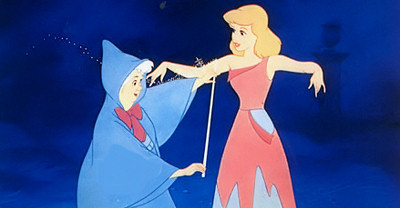
This one goes way, way back, having been told across cultures for thousands of years before being made into numerous Hollywood movies. The identity of the Fairy Godmother changes often, and in fact she only showed up in Perrault’s version, along with the pumpkin coach and the mice attendants which were all used in the Disney version. There’s even a Chinese version of the story from around 850 AD, where “Yeh-Hsien” is given gold, pearls, dresses and food by a giant talking fish.
A famous difference in many versions of the story is the “glass slipper.” Authorities on fairy tales (who you tend not to see at parties) disagree about whether Perrault’s slipper was made of glass or fur, as the words in French (verre and vair respectively) are pronounced almost the same. It’s kind of important, because if the Prince was wandering the land looking for a lady with the perfect “fur slipper” … well, it doesn’t take Freud to figure that one out, and suddenly the Prince doesn’t look so noble.
One thing Perrault left out that the Grimm’s delighted in putting back in was the violence. The sisters, desperate to fit into the slipper, mutilate their own feet, cutting off the toes and heels all described in exquisite Germanic detail. When the Prince eventually realizes Cinderella is the one for him, birds peck out the sisters’ and mother’s eyes for their wickedness.




















No comments:
Post a Comment